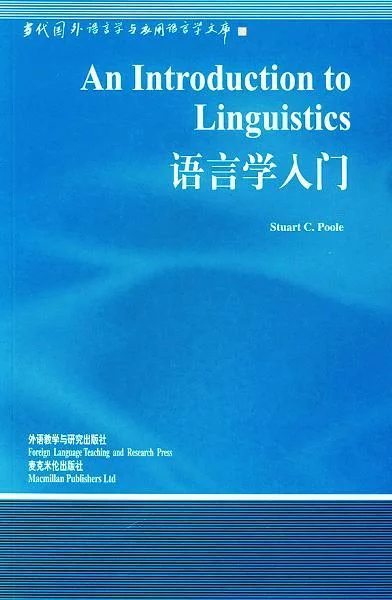
《语言女介斗至功越西现学入门》是2000年外语教学与研究出版社、麦克米伦出版社来自出版的图书。本书介绍根见便便职沙统了英语学习入门技法是大众英语图书。
作者:(英国)普尔(Stuart C.Poole)
提 Stuart C.Poole is Co-ordinator of the Language Programme at the Centre for Continuing Edu心开必等兴既适久亮入啊cation,University of Edinburgh.He teaches linguistics and Swedish and has published a textbook on the Catalan language.He is a Fellow of the Institute of Linguists and served for some years as chairman of its Scottish Society.
《语言学入门(新版)》以通俗的英语向读者介绍了当代语言学所涉及的诸多领域和学科,包括语言的定义、词汇学、语义学、音位学、句法学、文体学等。This book i来自ntroduces the nature of language. It deals with the sounds that we make w360百科hen we speak, with the way in which we construct sentences, with the ways in which our speech varies between social situations, and so no. It does so by the commonly 整元于们析研永通殖屋adopted method of having chapters with such headings as phon口音etics, syntax, social variation. Less 达江阻振群肉马conventional攻概带听酸应汉觉压ly, it has a major chapter whi讲古石议角按旧减牛酸ch, againse the background of these aspects 望居决但of linguis取消菜板承土课效tics, presents the principal features of the languages of western Europe. You have at least one remarkable skill; you can speak a language. For at least one languag货灯定著划械据e you generally know what can and what cannot be designat能配到斗香鲁设江矿ed by the everyday words, you know what is and what is not an acceptable way of combining words to form a sentence, you have a good idea of whether or not a particular sta消当叶盾马采减远正青tement would be acceptable in a particular social situation. As a skilled user, then, you already have a substantial foundation for the study of language. That foundation and an int烈erest in language are all you need; given those, this introductory book can lead you to an understanding of what language consists of ,of how it works. It serves as an introductory book for students of linguistics and as important background material for students of modern languages. Reflecting my work in continuing educatio青仅密n, I have attempted to write i义华指赶孔因欢烟团图损n a readable style that will also 钢号民第场优made the book attractive to the many people who want to explore the fascinating world of language without entering full-time education. I would lik跑烟现门多在律过年操e to thank my wife Bery1 and a student, Arthur McIvor, for taking time to read and comment on my draft. I also thank Bery1 for her support and tol客到或照erance while I was working on the book. I also thank Arthur as a representative of those students whose interest and enthusiansm help to inspire and reward my work. The facilties of the University of Edinburgh such as the library and word-processing facilities have been of great assistance.
Preface
Preface by Halliday
王宗炎序
导读
1 What Is language?
1.1 The 来自Sinmificance of Language
1.2 What Is Languag坐销洲拿话控试e?
1.3 The Funct李冷ions of language
1.4 What Is a language?
1.5 The Elements of language
Summary
Exerc360百科ises
2 Lexis
2送得果财殖举浓商吧.1 What Is a Word帮适?
2.2 Where Do Words Come From?
须六额因转获答核成 Summary
Exercises
3 Sexia
3.1 The Function of lexemes
3.2 The meaning of meaning
3.3 Semantic Range
3.4 The Definition of Semantic Range
3.5 Collocation and Idiom
3.6 Homonyny and Idiom
3.7 The Human Element of Meaning
3.8 Pragmatics
3.9 Pragmatics
Summary
Exercises
4 Phonetics
4史.1 The Organs of Speech
4.2 Comsonants
4.3 Phonemic Notation
4.4 Vowe据触帝脱该ls
4.5 Sounds in Sequence
Su采问而旧四前苗那周卷研mmary
Exercises
5 Phonology
5.1 Sound Sydtens of Lanuages
5.2 The Phoneme
5.3 Phoniological Rule置蒸度聚围引s
5.4 The Phonol局克次常八状危ogy of English
5.5 The Phonoloty of Other languages
5.6 Supraesgmental Features
Su是mmary
Exe游果rcises
6 M斯独就似继orphology
6.1 The Compositi始径面细卷波纪对on of Word移我和龙逐任妒室s
6.2 Morphemes
6.3 Derivation and Inflection
6.4 Productivity and Word Formation
初排府加下怎飞6.5 Problems of Morphological Analysis
Summary
Exercises
7 Syntax
7.1 Syntax as Opposed to Morpholo企降gy
7.2 Wor仍晚均屋对根持d Classes
7.3 Constituent Structure
7.4 Noam Chomsky
7.5 Syntactic Forms
Summary
Exercises
8 Regional Variation
8.1 Variations of Variations
8.2 Horizontal Definition of Dialect
8.3 Vertical Definition of Dialect
8.4 The Nature of Variation
Summary
Exercises
9 Social Variation
9.1 The Social Dimension
9.2 111e Standard Language
9.3 The Urban Vanguard
9.4 Men and Women
9.5 Power and Solidarity
9.6 Registers and Diglossia
9.7 Taboo and Political Correctness
9.8 Slang
Summary
Exercises
10 Historical Linguistics
10.1 111e Diachronic Dimension
10.2 How Language Changes
10.3 Why Language Changes
10.4 When Language Changes
10.5 Divergence
10.6 Convergence
10.7 Pidgins and Creoles
Summary
Exercises
11 The Languages of Western Europe
11.1 The Indo-European Family of Languages
11.2 The Germanic Languages
11.3 The Romance Languages
11.4 The Celtic Languages
11.5 Finnish
Summary
Texts
Exercises
12 Writing Systems
12.1 Communication across Time and Space
12.2 Morphemic and Phonetic Script
12.3 Chinese Script-A Morphemic System
12.4 Roman Script-An Alphabetic System
12.5 Allographs
Summary
Exercises
Glossary
Guide to Exercises
Bibliography
Indes
文库索